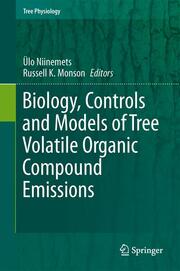-
Zusatztext
-
InhaltsangabePreface; Ülo Niinemets, Russell K. Monson Chapter 1 Diversification of Volatile Isoprenoid Emissions from Trees: Evolutionary and Ecological Perspectives; Silvia Fineschi, Francesco Loreto, Michael Staudt, Josep Peñuelas Chapter 2 BVOC Mediated Plant-Herbivore Interactions; Amy M. Trowbridge, Paul C. Stoy Chapter 3 The Biochemistry and Molecular Biology of Volatile Messengers in Trees; Hamid Rajabi Memari, Leila Pazouki, Ülo Niinemets Chapter 4 Genetic Engineering of BVOC Emissions from Trees; Maaria Rosenkranz, Jörg-Peter Schnitzler Chapter 5 Molecular and Pathway Controls on Biogenic Volatile Organic Compound Emissions; Ziru Li, Thomas D. Sharkey Chapter 6 Metabolic and Gene Expression Controls on the Production of Biogenic Volatile Organic Compounds; Russell K. Monson Chapter 7 The Roles of Stomatal Conductance and Compound Volatility in Controlling the Emission of Volatile Organic Compounds from Leaves; Peter C. Harley Chapter 8 The Role of Volatile Organic Compounds in Plant Resistance to Abiotic Stresses: Responses and Mechanisms; Malcolm Possell, Francesco Loreto Chapter 9 Flooding-driven emissions from trees; Jürgen Kreuzwieser, Heinz Rennenberg Chapter 10 Modification of BVOC Emissions by Changes in Atmospheric [CO2] and Air Pollution; Carlo Calfapietra, Emanuele Pallozzi, Ilaria Lusini, Violeta Velikova Chapter 11 Multitrophic Signalling in Polluted Atmospheres; Jarmo K. Holopainen, Anne-Marja Nerg, James D. Blande Chapter 12 Leaf-Level Models of Constitutive and Stress-Driven Volatile Organic Compound Emissions; Rüdiger Grote, Russell K. Monson, Ülo Niinemets Chapter 13 Scaling BVOC Emissions from Leaf to Canopy and Landscape: How Different Are Predictions Based on Contrasting Emission Algorithms?; Ülo Niinemets, Paolo Ciccioli, Steffen M. Noe, Markus Reichstein Chapter 14 Upscaling Biogenic Volatile Compound Emissions from Leaves to Landscapes; Alex Guenther Chapter 15 Scaling Emissions from Agroforestry Plantations and Urban Habitats; Susan M. Owen, C. Nicholas Hewitt, Claire S. Rowland Chapter 16 Global Modeling of Volatile Organic Compound Emissions; Kirsti Ashworth, Christophe Boissard, Gerd Folberth, Juliette Lathière, Guy Schurgers Chapter 17 Climate Feedbacks Linking the Increasing Atmospheric CO2 Concentration, BVOC Emissions, Aerosols and Clouds in Forest Ecosystems; Markku Kulmala, Tuomo Nieminen, Robert Chellapermal, Risto Makkonen, Jaana Bäck, Veli-Matti Kerminen Chapter 18 State-of-the-art of BVOC research: what do we have and what have we missed? A Synthesis; Ülo Niinemets, Russell K. Monson
-
-
Kurztext
-
The book deals with a highly relevant interdisciplinary topic: tree-atmosphere interactions. Plant-driven volatile organic compound (BVOC) emissions play a major role in atmospheric chemistry, including ozone and photochemical smog formation in the troposphere, and they extend the atmospheric lifetime of the key greenhouse gas, methane. Furthermore, condensation of photo-oxidation products of BVOCs leads to formation of secondary organic aerosols with profound implications for the earth's solar radiation budget and climate. Trees represent the plant life form that most contributes to BVOC emissions, which gives global forests a unique role in regulating atmospheric chemistry. This book, written by leading experts in the field, focuses on recent advancements in understanding the controls on plant-driven BVOC emissions, including efforts to quantitatively predict emissions using computer models. Particular emphasis is on elicitation of emissions under biotic and abiotic stresses, molecular mechanisms of volatile synthesis and emission and the role of emissions in plant stress tolerance. Potentials and limitations of genetic engineering of volatile emissions are also covered. This book addresses all biological scales of organization from molecules to globe and makes a major leap in summarizing and synthesizing the existing information. The main goal of the book is to provide state-of-the-art summary of the exciting field of tree volatile emissions and offer a perspective for future investigations. The book is intended to serve as an invaluable resource for graduate students starting a thesis project on tree volatile emissions as well as serves as a contemporary source of reference for teachers, scientists and professional within and outside the exciting field of plant-driven volatile emissions.
-
Detailansicht
Biology, Controls and Models of Tree Volatile Organic Compound Emissions
Tree Physiology 5
ISBN/EAN: 9789400766051
Umbreit-Nr.: 4443387
Sprache:
Englisch
Umfang: xv, 547 S.
Format in cm:
Einband:
gebundenes Buch
Erschienen am 19.07.2013
Auflage: 1/2013


